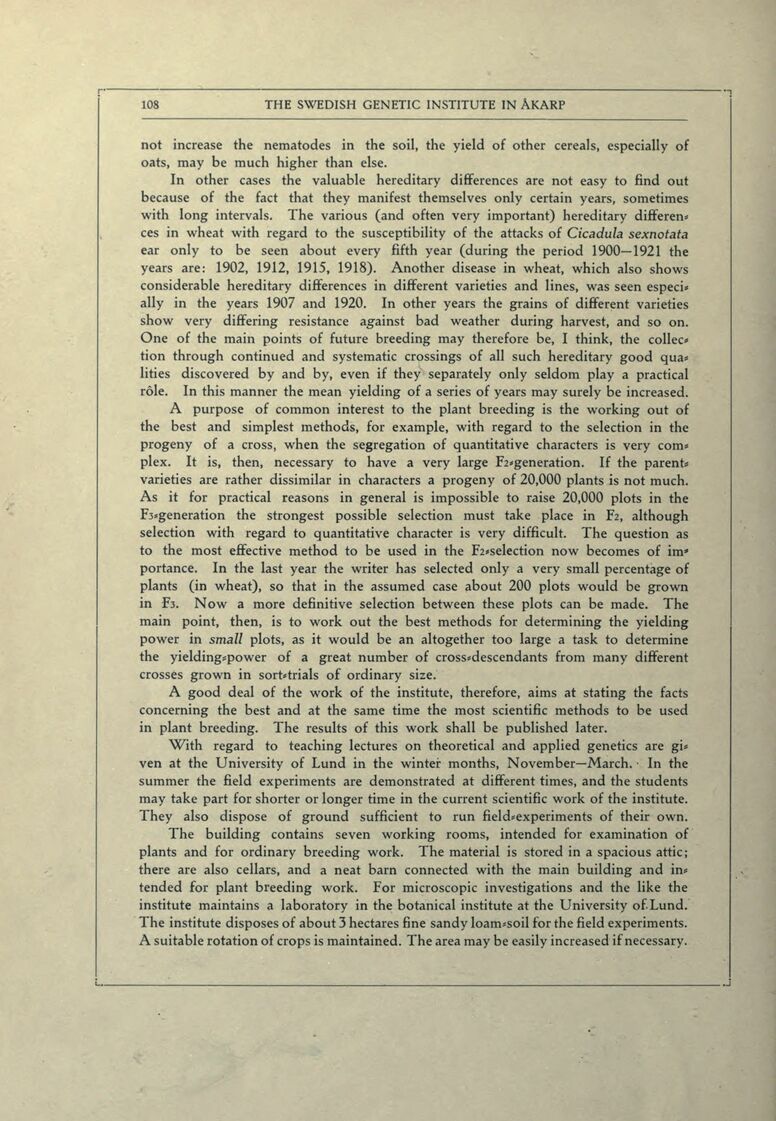
Full resolution (JPEG) - On this page / på denna sida - Part I - Professor Herman Nilsson-Ehle, Lund, Some Remarks on the Work of the Swedish Genetic Institute in Åkarp

<< prev. page << föreg. sida << >> nästa sida >> next page >>
Below is the raw OCR text
from the above scanned image.
Do you see an error? Proofread the page now!
Här nedan syns maskintolkade texten från faksimilbilden ovan.
Ser du något fel? Korrekturläs sidan nu!
This page has never been proofread. / Denna sida har aldrig korrekturlästs.
not increase the nematodes in the soil, the yield of other cereals, especially of
oats, may be much higher than else.
In other cases the valuable hereditary differences are not easy to find out
because of the faet that they manifest themselves only certain years, sometimes
with long intervals. The various (and often very important) hereditary differens
ces in wheat with regard to the susceptibility of the attacks of Cicadula sexnotata
ear only to be seen about every fifth year (during the period 1900—1921 the
years are: 1902, 1912, 1915, 1918). Another disease in wheat, which also shows
considerable hereditary differences in different varieties and lines, was seen especi»
ally in the years 1907 and 1920. In other years the grains of different varieties
show very differing resistance against bad weather during harvest, and so on.
One of the main points of future breeding may therefore be, I think, the collec»
tion through continued and systematic crossings of all such hereditary good qua«
lities discovered by and by, even if they separately only seldom play a practical
réle. In this manner the mean yielding of a series of years may surely be increased.
A purpose of common interest to the plant breeding is the working out of
the best and simplest methods, for example, with regard to the selection in the
progeny of a cross, when the segregation of quantitative characters is very com=
plex. It is, then, necessary to have a very large F2*generation. If the parent*
varieties are rather dissimilar in characters a progeny of 20,000 plants is not much.
As it for practical reasons in general is impossible to raise 20,000 plots in the
F3*generation the strongest possible selection must take place in F2, although
selection with regard to quantitative character is very difficult. The question as
to the most effective method to be used in the F2»selection now becomes of im<
portance. In the last year the writer has selected only a very small percentage of
plants (in wheat), so that in the assumed case about 200 plots would be grown
in F3. Now a more definitive selection between these plots can be made. The
main point, then, is to work out the best methods for determining the yielding
power in small plots, as it would be an altogether too large a task to determine
the yieldingspower of a great number of cross^descendants from many different
crosses grown in sorMrials of ordinary size.
A good deal of the work of the institute, therefore, aims at stating the facts
concerning the best and at the same time the most scientific methods to be used
in plant breeding. The results of this work shall be published later.
With regard to teaching leetures on theoretical and applied genetics are gis
ven at the University of Lund in the winter months, November—March. In the
summer the field experiments are demonstrated at different times, and the students
may take part for shorter or longer time in the current scientific work of the institute.
They also dispose of ground sufficient to run field*experiments of their own.
The budding contains seven working rooms, intended for examination of
plants and for ordinary breeding work. The material is stored in a spacious attic;
there are also cellars, and a neat barn connected with the main building and in*
tended for plant breeding work. For microscopic investigations and the like the
institute maintains a laboratory in the botanical institute at the University of. Lund.
The institute disposes of about 3 hectares fine sandy loarmsoil for the field experiments.
A suitable rotation of crops is maintained. The area may be easily increased if necessary.
<< prev. page << föreg. sida << >> nästa sida >> next page >>